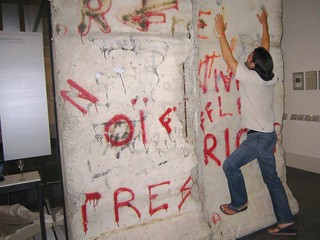I’ve been German for 30-odd years and lived in Berlin most of them. Yet, the other week, when a dear friend visited my hometown for the first time, learned things about the city and German history that I hadn’t been aware of. And I’d recommend the following tour to anyone – Berliners, Germans, and visitors from near and far.
Start off with the German Historical Museum at Unter den Linden, not far from the Museum Island. We did that only on the third day but I think it’s a better starting point.
The German Historical Museum is – you guessed it – about German history. It begins with Roman times when “the Germans” were merely a part  of a story told back in Rome: about fierce warriors in the Northeast that the mighty Roman army couldn’t defeat.
of a story told back in Rome: about fierce warriors in the Northeast that the mighty Roman army couldn’t defeat.
I like most about the museum that you can easily spend two days in there, delving in the exhibits, opening all those drawers (literally), which contain extra bits of information. On the other hand, if you only have a limited amount of time, you can also just browse through the displays, maybe read the texts on the panels marking the beginning of a new section and providing an overview of how and where events unfolded and who the main characters were.
The exhibition ends with the early 90s, shortly after the fall of the Berlin Wall. But you can almost ignore the 20th-century sections as there are a few quite intriguing museums dedicated to certain elements of it which I’ll get to in the second part of this post.
In addition to the regular exhibition, the German Historical Museum showcases artifacts from its vast collection in special  exhibitions at the new I.M. Pei wing. To give you an idea of the range of topics of these exhibitions: Currently, they are running one called “Around the World” with tourism posters from the 1920s to the 1960s, and another one called “Gulag: Traces and Testimonies, 1926-1956”, showing relics and testimonies to the Soviet camp system. All exhibitions are included in the general admission, which is 8? (4? for students and seniors, children under 18 get in for free). Also neat: The ticket is valid all day (opening hours: 10 am to 6 pm).So you can leave the museum and pick up lunch at Alexanderplatz or Hackescher Markt, where it’s a lot cheaper than at the museum’s café/restaurant.
exhibitions at the new I.M. Pei wing. To give you an idea of the range of topics of these exhibitions: Currently, they are running one called “Around the World” with tourism posters from the 1920s to the 1960s, and another one called “Gulag: Traces and Testimonies, 1926-1956”, showing relics and testimonies to the Soviet camp system. All exhibitions are included in the general admission, which is 8? (4? for students and seniors, children under 18 get in for free). Also neat: The ticket is valid all day (opening hours: 10 am to 6 pm).So you can leave the museum and pick up lunch at Alexanderplatz or Hackescher Markt, where it’s a lot cheaper than at the museum’s café/restaurant.
For more information head over to www.dhm.de, the German Historical Museum’s website.
Now you got your overview of German history it’s time to dig into two phases of that history that mainly define how Germans perceive themselves today: In tomorrow’s post I’ll talk about two places where you can learn about Germany in WWII and the separation of the country through the wall.